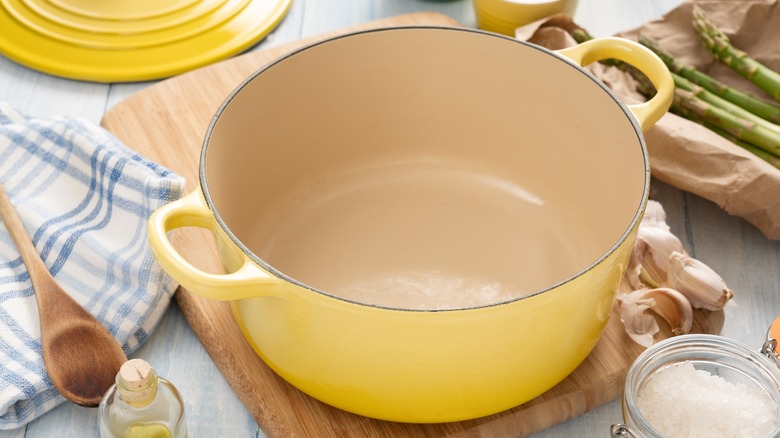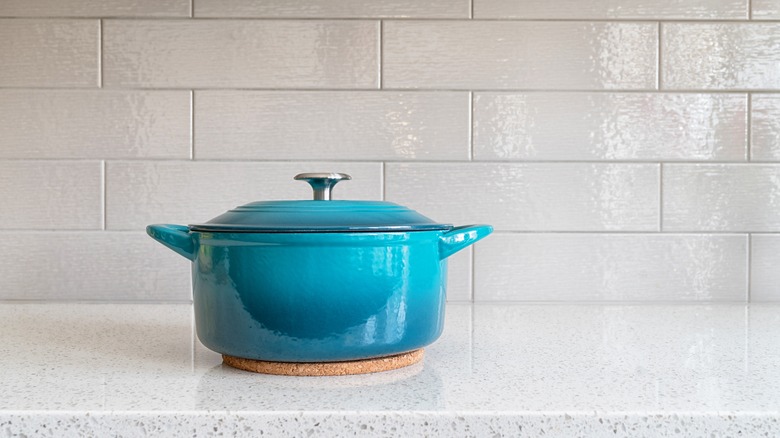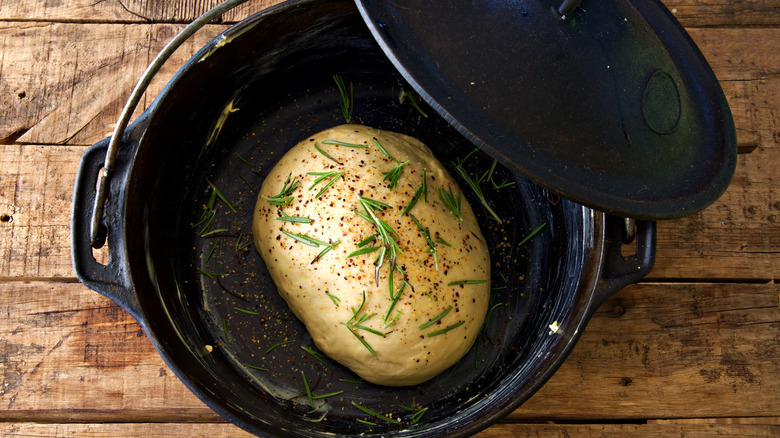The Type Of Cleaner That Should Never Touch Your Dutch Oven
Ask any veteran cook what their favorite kitchen hardware is and they may very well say a Dutch oven. These thick vessels can be used to cook everything from Irish quick bread to pasta. Many models are covered with a colorful enamel finish that is smooth to the touch and shiny. They're crafted with thick walls (often made of cast iron) and sport a tight-fitting lid. Because of this construction, Dutch ovens are quite heavy and are excellent at holding heat. This impressive heat-retention ability is what makes them such a versatile and unique kitchen tool.
After a large meal, Dutch ovens can end up holding quite a mess. Whether you're dealing with splattered chili or the gooey remnants of a homemade mac n cheese, you'll need to properly clean your oven before its next use. However, employing the wrong cleaning techniques can alter the look of your pot and potentially even ruin its seasoning. Before you grab your steel wool, it's essential that you understand the safe way to scrub out your enameled cast iron. Be especially careful to steer clear of citrus-based cleaners, which can damage a Dutch oven's exterior.
Avoid citrus cleaners
Cast iron manufacturer Lodge warns that applying any citrus (or even citrus-based cleaner) to an enameled Dutch oven can potentially dull its glossy finish. Lodge notes that the negative effects of citrus are purely aesthetic; they won't impact the cooking ability of the pot. This means that you definitely shouldn't use the lemon and baking soda trick to deodorize or scrub your Dutch oven.
Beyond citrus, several other cleaning methods should be off-limits for enamel-coated cast iron. Avoid abrasive materials that could scratch the surface, like steel wool and metal utensils. While many Dutch ovens are marked as "dishwasher safe," you should handwash these pots if possible to maintain the smooth and shiny finish.
Without the aid of your favorite wiry scrubber or handy dishwasher, how do you effectively wash a Dutch oven? Scrub gently by hand with a small amount of soap. If bits of food are stubbornly stuck, Lodge recommends simmering a bit of water in the pot to loosen it instead of scouring the inside with coarse cleaning supplies. Once clean, immediately dry the cookware and store it in an area with low moisture.
What about cast iron?
Not all Dutch ovens are coated in enamel. Some sport a cast iron exterior and require additional cleaning. It's important to note that cast iron pots and pans are seasoned. Seasoning cast iron is a process that coats the interior with a layer of oil that prevents rust and turns the rough finish into a nonstick surface. Many pots and pans come pre-seasoned, but others will need a round of seasoning before you can use them.
While rough materials will only damage the look of the enamel finish, they might actually ruin the seasoning — and thus cooking ability — of cast iron. When cleaning cast iron Dutch ovens, you must avoid harsh cleaning materials and chemical agents. Wires and excessive soap can accidentally strip the layer of seasoning, forcing you to re-season the entire surface.
When your cast iron Dutch oven is clean, quickly dry it completely with a towel. Afterward, gently wipe the entire interior with a very small amount of cooking oil to maintain the seasoned finish. If you have trouble finding storage space for this bulky kitchen container, you can always leave it clean and shining as a decoration on the stove.


